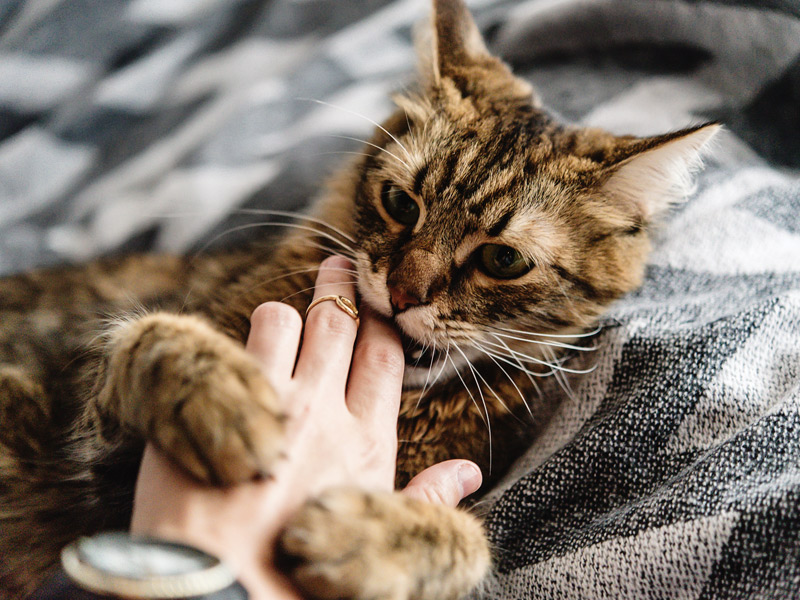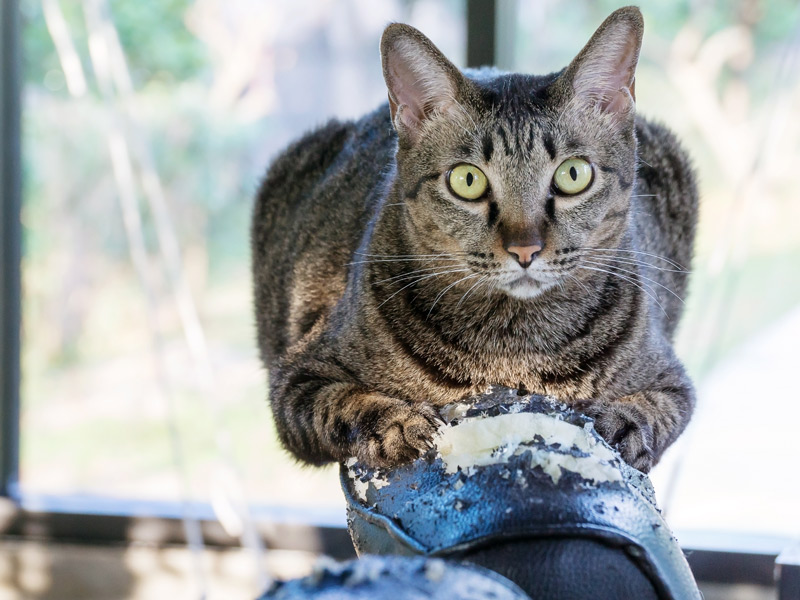CAT COSTS 101: WHAT EXPENSES TO EXPECT WHEN ADOPTING A CAT
Thinking of adopting a cat? Make sure you can afford it first. We break down the costs of cat ownership, so you know what to expect before you adopt.

5 Common Cat Behavior Problems and Solutions
While cats are amazing, complex and unique creatures, life with felines isn’t all cuddles and catnip. Scratching, spraying, and other common cat problems can leave you feeling frustrated and out-of-sync with your four-legged friend.
If you find yourself in this situation – don’t despair! Many of these behavioral problems have simple solutions.
The first thing to note is if you notice your cat engaging in destructive behaviors, schedule a trip to the vet to rule out underlying health issues.
HOW TO SOLVE THE TOP 5 CAT BEHAVIOR ISSUES
1. Cats That Bite or Scratch People.
Feline aggression can derail the coziest of cat-human relationships. If your cat is getting under your skin (literally), ask yourself: has my cat always been a biter, or is this behavior new?

Whether you have a long-term biter or a newbie to the scratch scene, there is hope for change. Most cats can be taught to be more gentle with people—as long as you give them plenty of opportunities to express their aggression in acceptable ways, like positive forms of play.
All cats need to play. They tackle, wrestle, swat, and bite. When your cat scratches or bites your hand, he probably thinks he’s playing with you. Never use your hands or feet to play with a kitten or cat. Get plenty of wands, feathers, scarves, and other interactive toys, and set aside at least 15 minutes every day to play with your cat.
2. Cats That Keep You Up at Night – Or Wake You Up Too Early In The Morning.
What’s the worst thing about a feline alarm clock? There’s no snooze button! If you’re getting dark circles under your eyes from dealing with your cat’s nighttime or early morning activity, try these solutions.

Understand your cat’s nighttime behavior. Is your cat waking you up “on purpose,” or is he just being too noisy after bedtime? If the answer is the latter, put the jingle bell toys away after dark, and replace them with soft, foam balls that your cat can bat around without waking up the whole house.
If your cat is purposely waking you up—for example, by coming into your room and meowing loudly or pawing your face-try to figure out what she’s trying to get from you. Is he bored or lonely? Make sure he has plenty of (quiet) toys. Provide plenty of stimulation, exercise, and companionship during the day so he doesn’t need to search for these during the night.
If you’re a one-cat household, consider getting your cat a companion to help keep them occupied and active during the dat.
Is she waking you up because she is hungry or thirsty? Make sure to provide her adequate sustenance during the day and provide plenty of water to last through the night.
3. Cats That Scratch Furniture, Clothes, or Rugs.

Does your cat have a habit of destroying your home furnishings? Try a little using behavior modification to curb her bad habits.
Scratching posts, and more scratching posts. Place these everywhere.
If you don’t want your cat to scratch up your sofa, you need to provide plenty of acceptable places to scratch. Invest in some posts your cat will actually use and sprinkle some catnip to encourage them to choose the post over your couch.
If you notice your cat scratching your clothes or furniture, gently discourage the behavior with a squirt from a water bottle). Provide enthusiastic, lavish praise every time she approaches a post.
4. Cats That Don’t Want to Use the Litter Box.
Litter box issues tend to be one of the more frustrating and difficult problems faced by cat parents. Litter aversion is the #1 reason cats are surrendered to shelters, but there are many ways to help combat this issue and help your cat learn to always use their box.

When it comes to litter aversion, it’s important to start by ruling out medical problems. An infection or other illness could be making it hard for your cat to control his bladder.
Next, consider the location of your cat’s litter box. Is it easily accessible, in a private but comfortable location? Just like you wouldn’t want to use the bathroom in a dingy, cold basement corner, your cat won’t want to either.
Make sure you provide plenty of litter boxes, especially if you have multiple cats, as they can become territorial. A good rule of thumb to stick to is to keep one litter box per cat, plus one extra. Make that they’re large and comfortable. You should also note how old the litter boxes are and replace any over 2-3 years old, as plastic boxes can absorb residual odors over the years.
In addition to these tips, try slowly transitioning to a litter with a cat attractant into your cat’s current litter, to help draw them to the litter box. Make sure to scoop the litter box daily to keep it clean and fresh.
5. Cats That Put The “Scared” in “Scaredy Cat.”

Cats are independent, but they are also social creatures by nature. Your shy kitty may never be the life of the party, but your dreams of feline cuddle time may still come true. It’s important to remain patient with your cat, as losing your temper can increase their anxiety and reclusive behavior.
Respect your cat’s need for space. Your cat needs alone time to feel comfortable and safe. Provide enclosed spaces that allow your cat to “hide” while still being part of the action. Try placing baskets or covered cat beds in social spaces, like the living room. If your cat can watch you from his safe space, he’ll gradually get more comfortable.
No one’s perfect, and your cat is an individual just like everyone else. If you can learn to accept her personal quirks, while curbing the more frustrating behaviors, you’ll soon be basking in cat-happy bliss. Want more cat care tips? We’ve got you covered.



